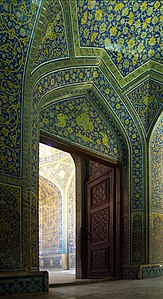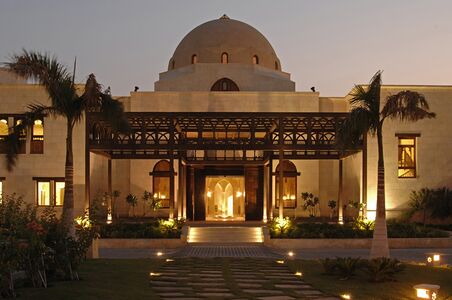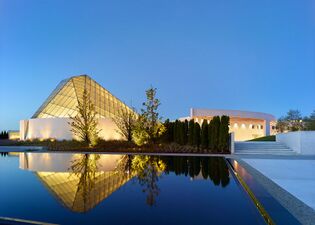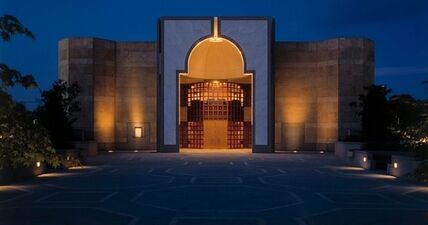Bayt al-Adhkar
| Part of a series on | |||||
| Esoteric Shi'ism | |||||
|---|---|---|---|---|---|
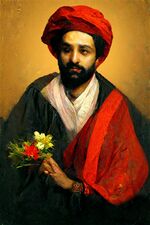 | |||||
| The Seven Figures | |||||
|
|||||
| The Seven Principles | |||||
|
|||||
| Beliefs and practices | |||||
| Place of worship | |||||
|
|||||
| Holy days | |||||
|
|||||
| Texts | |||||
| Governance | |||||
A Bayt al-Adhkar, or more commonly a House of Remembrance, is one of several types of Esoteric Shia places of worship, the others being the House of Sorrows (bayt al-ahzan) and the Mosque. Houses of Remembrance act as the focal point of Esoteric Shia religious life. An empty throne symbolising the spiritual authority of the Hidden Imam, ablution points where congregants may perform ablution to achieve ritual purity and an assembly hall in which congregants may recite the Fifteen Whispered Prayers and perform other rituals of remembrance, such as the dhikr and quiet meditation are all common features of a House of Remembrance.
Houses of Remembrance are divided into two types. A local House of Remembrance, which serves a commune in Hindia Belanda or entire cities outside Hindia Belanda, is headed by a Mualim. In Hindia Belanda, larger Houses of Remembrance are called Provincial Houses of Remembrance as they are often built to serve an entire province, although they are more accurately known as a "Bayt al-Adhkar al-Kabir". For this reason, Provincial Houses of Remembrance typically form a complex of building, often incorporating shrines, landscaped gardens, a visitor centre, an exhibition hall and other facilities, which may include educational institutes and a pilgrims' house. A Provincial House of Remembrance is led by a Panghoeloe, who is assisted by a number of Mualims. Outside Hindia Belanda, all Houses of Remembrance, irrespective of size, are classified as local Houses of Remembrance and are led by a number of Mualims, depending on size of the local congregation.
Unlike the traditional mosque, the House of Remembrance often features iconographies of the Islamic Prophet, his daughter Lady Fatima, the Twelve Infallible Imams and other Esoteric Shia holy figures. For this reason, the Canonical Prayers which are said thrice a day by Esoteric Shias are not to be performed in a House of Remembrance as the absence of visual imagery is one of its requirements. Many Houses of Remembrance, however, often include an additional prayer hall bereft of visual art set for this purpose whilst others are situated adjacent to a mosque to enable worshippers to fulfil their daily religious obligations. As Esoteric Shi'ism does not place an emphasis on performing the daily Canonical Prayers congregationally due to the continuing absence of the Hidden Infallible Imam (a congregational Canonical Prayer is obligatory upon Shias only in the presence of an Infallible Imam), there have been few attempts at constructing Shia mosques in Hindia Belanda, Maqtajer and the rest of Astyria.
Origins
The origins of the House of Remembrance can be traced to the early Shia practice of remembrance rituals under Sunni regimes following the death of the Islamic Prophet, during which the Shia faithful would often secretly assemble in a room of a house to recite or listen to a reading of the sacred texts, eulogies and intercessory prayers – practices that were otherwise forbidden by the state. With the spread of Shi'ism to what is now southeastern Maqtajer, purpose-built Houses of Remembrance started to emerge in Sythith.
Evolution
Functions
Administrative
The House of Remembrance is often but not always the centre of the local Esoteric Shia jurisdiction. It is where
Religious
Rituals of Remembrance
Fifteen Whispered Prayers
Passion plays
Sacred musical performance
Architecture
Shia traditional architecture
Early Houses of Remembrance built in Astyria are located in the southwestern parts of Maqtajer and western parts of Hindia Belanda. The styles of these early Houses of Remembrance predominantly follow Shia traditional architecture.
Vestibule, Srambi Katashahr House of Remembrance
Main assembly hall, Srambi Katashahr House of Remembrance
Javanese Fusion
Austronesian
Andjanian
Colonial
Shia Revival

